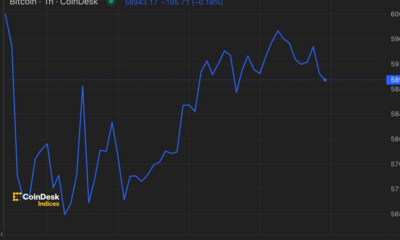Bitcoin
Trump seeks cryptocurrency industry support at bitcoin conference

NASHVILLE — There were stacks of orange coins, a crypto-themed stock car and a plethora of miniature rockets meant to embody the hope that prices might shoot “to the moon.”
But the usual trappings accompanied a more political sight at the annual conference that bills itself as the world’s largest gathering of bitcoin enthusiasts: klaxon-red hats emblazoned with the slogan “Make bitcoin Great Again.”
Many of the nation’s leading cryptocurrency companies, executives, investors and fanatics are beginning to unite around former president Donald Trump, hoping their public embrace — and increasingly generous campaign checks — might entice and elect a presidential candidate who will spare the industry from federal regulation.
“This is the steel industry of 100 years ago,” Trump said in a direct appeal to crypto supporters here Saturday, promising he would turn the United States into the “crypto capital of the planet and the bitcoin superpower of the world.”
Under President Biden, the U.S. government has aggressively cracked down on crypto, seeking to protect average Americans from scams and prevent the largely anonymous tokens from enabling illicit activities. But the fierce oversight has chafed crypto advocates and angered wealthy political benefactors in Silicon Valley. To ward off new federal probes, environmental protections and financial regulations, they have gravitated toward Trump — even if they don’t always like him — in the hope that he will deliver relief in Washington.
“I think what people are excited about is, if Trump comes in with a new circle, and Cabinet members, and people, that it’s going to change, and change for the better,” said Marshall Beard, the chief operating officer at Gemini, a crypto trading platform and banking service. He described himself as apolitical, but his company’s founders, billionaire investors Tyler and Cameron Winklevoss, have donated heavily in support of Trump.
Trump has gladly accepted the entreaties: Newly awash in crypto cash, he has celebrated bitcoin and other digital tokens, marking a shift from his time in office, when Trump proclaimed he was “not a fan” of bitcoin and linked such assets to drug sales. The early uptick in fundraising support has troubled some Democrats, who have scrambled to show they are not hostile to the industry.
Trump’s conversion was on stark display Saturday, as he addressed thousands of bitcoin owners, traders and investors. In a winding speech, rife with attacks on Democrats, the former president pledged his administration would pursue crypto policies “written by people who love your industry” — even promising at times that the price of bitcoin would rise under his watch.
Even before Trump arrived, there were hints of growing support across the sprawling Music City Center. A smattering of “Make bitcoin Great Again” hats — some in bitcoin orange — dotted the rows of booths where crypto entrepreneurs hawked new tokens, investing tips and “tax avoidance strategies,” in the words of one firm, which parked near its kiosk a ruby-red motorcycle adorned with the play on Trump’s slogan. (Staff there declined to be interviewed.)
Outside, a digital sign truck periodically circled, flashing photos of Trump and his new running mate, Sen. JD Vance (R-Ohio), a longtime crypto advocate who has reported owning as much as $250,000 in bitcoin. The vehicle pitched passersby on “MAGA VP,” a type of “memecoin” — unaffiliated with the campaign — that aims to help the former president’s most fervent supporters earn money. It teased that customers who purchased $50 of the token would “win a special prize.”
“At this party, today, it seems like there’s a leaning toward Trump, and I think it’s an appreciation for the first major presidential candidate to come along and say this might be actually a really good idea,” said Mike Belshe, the chief executive of BitGo, which offers a crypto wallet service. He plans to host a fundraiser next week for Vance in Palo Alto, Calif., according to an invite obtained by The Washington Post.
The support for Trump underscored the rapid political awakening underway in the crypto industry. Stung by a series of major scandals — and facing the prospect of tough regulation in Washington — crypto companies, executives and investors have shelled out $121 million this election in a bid to defeat potential foes and elect new friends in Washington, according to the money-in-politics watchdog OpenSecrets.
“We’ve seen tens of millions of dollars pouring in, in an attempt to make sure anti-regulation politicians are the ones who take power,” said Lisa Gilbert, co-president of Public Citizen, a left-leaning watchdog group.
For many crypto titans, the catalyst for action came two years ago, after the downfall of FTX, previously the world’s third-largest crypto marketplace. Many Democrats, including Sen. Elizabeth Warren (Mass.), immediately demanded stringent new rules, while the Securities and Exchange Commission, led by Chairman Gary Gensler, filed a battery of lawsuits alleging that the best-known crypto firms had failed to follow basic federal investor protections.
Often, the targets of SEC scrutiny — including Coinbase, a digital asset marketplace, and Ripple, which created the popular XRP token — blasted the cases as evidence of Gensler’s bias against the industry. They coupled their court battles with an expensive lobbying campaign designed to neuter the SEC and stave off other regulations, including rules meant to prevent terrorist groups from trafficking in crypto. And crypto executives and investors began pouring money into the 2024 election, launching three super PACs that have run ads targeting congressional candidates who oppose digital currencies.
This year, David Bailey — the chief executive of BTC Inc., which organized the conference in Nashville — personally approached Trump in the hope he might reverse his views on crypto. Major Silicon Valley donors, including investors David Sacks and Chamath Palihapitiya, hosted lucrative fundraisers for the former president in June. Elon Musk, a crypto booster and owner of X, endorsed Trump after the July 13 assassination attempt in Butler, Pa.; the venture capital duo Marc Andreessen and Ben Horowitz soon revealed their support, too.
With every check and endorsement, Trump appeared to grow more receptive. On his social media site, Truth Social, he described himself in May as “VERY POSITIVE AND OPEN MINDED TO CRYPTOCURRENCY COMPANIES.” Two months later, he touted crypto as an official part of the 2024 GOP platform, which declared the party would “end Democrats’ unlawful and un-American Crypto crackdown.”
“If there’s a politician that sees the potential of the industry, and wants it to thrive, generally the voters and donations are going to go in that direction,” said Brian Morgenstern, who oversees policy for the crypto giant Riot Platforms.
Riot is a bitcoin miner: It manages the vast, energy-intensive machines running complex calculations to generate individual tokens. The industry has warred with the Biden administration, and Riot successfully sued the Energy Department after it demanded bitcoin miners turn over data about their energy usage.
Executives from Riot and other companies directly appealed in June to Trump, who told them “he understands quite clearly why people are looking for alternatives to legacy financial systems,” Morgenstern recalled in Nashville this week. Morgenstern served under Trump in the Treasury Department, back when the president had been critical of crypto.
After the meeting, Trump commemorated the gathering on Truth Social: “VOTE FOR TRUMP!” he began. “Biden’s hatred of bitcoin only helps China, Russia, and the Radical Communist Left. We want all the remaining bitcoin to be MADE IN THE USA!!!”
Despite his earlier opposition, some crypto devotees seemed to welcome Trump’s attention.
At an unattended expo booth Friday, the image of a bloodied Trump pumping his fist after the assassination attempt had been altered so he appeared to be holding a bitcoin. Gawkers stopped to snap photos of the rotating illustration, which was superimposed atop the usual rocket logo for Moonshot, a company that manufactures key components for bitcoin mining.
“Hopefully we’re starting to see winds change in the United States, and maybe we’ll get some change with a new president,” mused Ray Kamrath, the chief commercial officer at Bakkt, a crypto trading platform, during a panel discussion later about the future of regulation.
Kamrath expressed hope that the next year might finally resolve the issue of whether some cryptocurrencies are securities, and in the process, shield more of the industry from the SEC.
“Let’s just enjoy for a moment that crypto, bitcoin, is a bona fide election-year issue in the United States,” responded Bobby Zagotta, the U.S. chief executive officer of Bitstamp, a crypto marketplace, to a smattering of applause. In an interview afterward, Zagotta said he sensed the “Trump mania just walking the floor.”
A crowd of a few hundred had erupted in celebration a day earlier, when Luke Rudkowski, the founder of the group We Are Change, noted on a panel that Trump had publicly promised to release Ross Ulbricht from prison. A longtime darling of the crypto community, Ulbricht faces a life sentence for convictions related to his creation and operation of Silk Road, a dark web marketplace often used to buy and sell illicit goods.
“It’s happening with Donald Trump; he’s speaking up for it,” said Rudkowski, whose group has been faulted by the Southern Poverty Law Center for spreading conspiracy theories.
On Saturday, Trump reiterated his commitment to Ulbricht as part of a series of crypto-friendly policy announcements meant to rile industry support. He pledged to fire Gensler and put an end to his agency’s tough enforcement, drawing an applause so loud that Trump said he didn’t realize the SEC chair “was that unpopular.” The former president also proposed a national strategic reserve of bitcoin, formed largely from currency that the U.S. government has seized from criminal investigations and other sources.
Trump addressed the Nashville audience on a day when he also had been scheduled to hold a high-dollar fundraiser with crypto executives. To attend the Saturday fundraising reception, take a photo with Trump and join his policy roundtable, donors had to write checks for $844,600 to his reelection and other Republican campaign committees, according to an invitation obtained by The Post. Previously, Trump’s aides boasted about raising roughly $4 million in various cryptocurrencies, including bitcoin.
Sensing Trump’s fundraising edge, other politicians have looked to court crypto’s cash: On street corners outside the convention hall, Sen. Marsha Blackburn (R-Tenn.) stationed trucks with digital signs that pitched her as a “bitcoin champion” — and directed viewers to a donation website (in dollars or cryptocurrency). Robert F. Kennedy Jr, who is running as an independent in the 2024 presidential race, made his own appeal Friday, telling a packed auditorium that he would unveil a host of policies that would see the U.S. government purchase and warehouse bitcoin.
“I’m very happy to learn I’m not the only one talking about bitcoin in this year’s election,” said Kennedy, who appeared at the same conference last year. He later added: “I hope President Trump’s commitment is about more than political expediency.”
But Trump’s inroads in particular have spooked some national Democrats, who do not want to be seen as wholly opposed to crypto. A small group of party officials even huddled privately earlier this month to discuss how to better engage with the politically ascendant industry, having spent years cultivating relationships — and cashing checks — from the broader, liberal-leaning Silicon Valley tech set.
“The challenge the Democrats have is name[d] Gary Gensler,” Mark Cuban, a prominent tech investor, said in an email. “He is pushing a new technology out of the USA. That is not a strong position for a party looking to win.”
Rep. Ro Khanna (D-Calif.), who represents a slice of the Bay Area, convened the gathering with senior aides to Biden and top tech investors including Cuban and Anthony Scaramucci, who served briefly under Trump but since has defected to support Biden and now Vice President Harris. Scaramucci later said that some participants specifically called for firing Gensler and blocking the renomination of Caroline Crenshaw for another term as an SEC commissioner, arguing they have struck an unfairly defiant tone against crypto. The White House did not respond to a request for comment; spokespeople for Gensler and Crenshaw declined to comment.
“I’ll put it simply: After years in the desert, and in a regulatory drought in the Biden administration, I think they see an advocate,” Scaramucci said of Trump.
The outreach has only intensified since Harris replaced Biden as the party’s presumptive nominee, elevating a longtime California politician with deep roots in the tech sector. Some fervent crypto supporters made a last-minute pitch for Harris to appear alongside Trump in Nashville. Her campaign did not respond to a request for comment.
“With the changing of the top of the ticket, it’s an opportunity to reevaluate, reset,” said Brad Garlinghouse, the chief executive of Ripple.
Garlinghouse said he had not yet endorsed or donated to either candidate, but he signaled that many in his industry had supported Trump primarily out of necessity.
“I don’t think this is about choosing one party over another,” he said. “I think the Republicans, led by Donald Trump, are playing chess, and I think the Democrats are playing checkers.”
Bitcoin
Bitcoin (BTC) Price Drops Below $65K After FOMC as Middle East Tensions Rise

Cryptocurrencies fell sharply on Wednesday as rising geopolitical risks captivated investors’ attention following the conclusion of the Federal Reserve’s July meeting.
Bitcoin (BTC) fell to $64,500 from around $66,500, where it traded following Federal Reserve Chairman Jerome Powell’s press conference and is down more than 2% in the past 24 hours. Major altcoins including ether (ETH)sunbathing (SUN)Avalanche AVAX (AVAX) and Cardano (ADA) also fell, while Ripple’s XRP saved some of its early gains today. The broad cryptocurrency market benchmark CoinDesk 20 Index was 0.8% lower than 24 hours ago.
The liquidation happened when the New York Times reported that Iran’s leaders have ordered retaliation against Israel over the killing of Hamas leader Ismail Haniyeh in Tehran, raising the risk of a wider conflict in the region.
Earlier today, the Fed left benchmark interest rates unchanged and gave little indication that a widely expected rate cut in September is a given. The Fed’s Powell said that while no decision has been made on a September cut, the “broad sense is that we are getting closer” to cutting rates.
While digital assets suffered losses, most traditional asset classes rose higher during the day. U.S. 10-year bond yields fell 10 basis points, while gold rose 1.5% to $2,450, slightly below its record highs, and WTI crude oil prices rose 5%. Stocks also rallied during the day, with the tech-heavy Nasdaq 100 index rebounding 3% and the S&P 500 closing the session 2.2% higher, led by 12% gains in chipmaker giant Nvidia (NVDA).
The different performances across asset classes could be due to traders’ positioning ahead of the Fed meeting, Zach Pandl, head of research at Grayscale, said in an emailed note.
“Equities may have been slightly underutilized after the recent dip, while bitcoin is coming off a strong period with solid inflows, while gold has recovered after a period of weakness,” he said.
“Overall, the combination of Fed rate cuts, bipartisan focus on cryptocurrency policy issues, and the prospect of a second Trump administration that could advocate for a weaker U.S. dollar should be viewed as very positive for bitcoin,” he concluded.
UPDATE (July 31, 2024, 21:30 UTC): Adds grayscale comments.
Bitcoin
No, Bitcoin Will Not Solve Our National Debt

Wyoming Republican Senator Cynthia Lummis speaks at the Bitcoin 2024 conference in … [+] Nashville, Tennessee, U.S., on Saturday, July 27, 2024. Former U.S. President Donald Trump said he would fire the chairman of the Securities and Exchange Commission and pick crypto-friendly regulators if he returns to the White House in a bid to woo virtual currency enthusiasts and capitalize on the industry’s growing influence in the political arena. Photographer: Brett Carlsen/Bloomberg
© 2024 Bloomberg Finance LP
At a Bitcoin conference last weekend, Senator Cynthia Lummis (R-Wyo.) announced future legislation that would direct the Treasury to purchase 1 million Bitcoin, or roughly 5% of the global supply, over five years (which would cost between $60 billion and $70 billion at today’s prices). Lummis claimed that the federal government would be “debt-free because of Bitcoin” if his proposal were to pass, because these Bitcoins could be sold by the federal government at a profit after 20 years. Unfortunately, there are mathematical and conceptual problems that prevent such an approach from solving the federal government’s budget problems.
Let’s start with the math: US National Debt Today stands at nearly $28 trillion (or $35 trillion if you include the “intragovernmental debt” that the general fund owes to other internal government accounting entities, such as the Social Security and Medicare trust funds). This year alone, the federal government spent about $2 trillion more than it took in in revenue, which had to be covered by borrowing money that adds to our national debt.
In comparison, the total market capitalization of Bitcoin today (which is the total number of Bitcoins in existence multiplied by their current market price) is only about $1.3 trillion — and that’s with Bitcoin’s current price near its all-time high. If all the Bitcoin in the world isn’t worth enough to cover a single year’s budget deficit, there’s no way buying 5% of it could plausibly stem the growth of, let alone pay off, our national debt. For the math to work, Bitcoin’s market cap would have to reach a level that is a multiple of the annual economic output of the entire planet (the International Monetary Fund current estimates the sum of each country’s gross domestic product is less than US$110 trillion).
But beyond the math, there are serious conceptual problems with Lummis’s proposal as a partial solution. When the government acquires an asset, it is typically reallocating rather than creating wealth. As the government buys some of the existing supply of Bitcoin, it would reduce the remaining supply available for others to buy on the market. If private demand for Bitcoin remains constant, the result would be an increase in the price of one Bitcoin. The beneficiaries of this transaction would be the current owners of Bitcoin (one of whom is Senator Lummis herself), because they would be in possession of an asset that can be sold at a higher price than the price at which it was originally purchased.
The increase in Bitcoin’s price, and thus the financial benefit to current holders, is likely to be even greater because, rather than remaining constant, private demand would increase as previously cautious investors view the U.S. government’s investment as an indicator of the digital asset’s legitimacy. These higher prices would not only increase demand for Bitcoin, but could also encourage Bitcoin “miners” to increase supply. Bitcoin mining is a extremely energy intensive process that relies on advanced graphics processing units (GPUs). If Bitcoin mining increases demand for GPUs, the GPUs themselves will become more expensive, as they did in 2020. In turn, every activity that depends on GPUs — from video editing to gaming — will also become more expensive.
Perhaps most alarmingly, a boom in Bitcoin mining threatens to stifle promising developments in artificial intelligence (AI). As other Forbes contributors point out, he wroteAI has the potential to revolutionize our economy and boost the productivity of our workforce in countless ways that would increase real wealth for Americans of all socioeconomic backgrounds. But AI also relies on advanced GPUs to function, of which there are already there is not enough supply to meet demand. It would be a profound failure of federal policy to make AI advances more costly to achieve by encouraging people to spend the resources needed to generate digital tokens. Furthermore, even if federal government Bitcoin purchases do not lead to an increase in Bitcoin mining, there are still other ways in which rising Bitcoin prices would displace productive economic investment — but rather than delve into them here, I recommend reading this great 2022 article by Josh Barro about the subject.
For these and other reasons, the federal government should not take any action to push the price of Bitcoin — or any other cryptocurrency, for that matter — above the level set by the free market. If policymakers believe that prices will continue to rise anyway and want to capture some of that value for deficit reduction, there are much better mechanisms for doing so. For example, a capital gains tax increase could aim to capture 5% of the gain on 100% of Bitcoin rather than capturing 100% of the gain on 5% of Bitcoin, as the Lummis proposal would seek to do. In addition to avoiding the market-distorting effects of the Lummis proposal, this approach has the added benefit of not leaving taxpayers holding the bag if the value of Bitcoin plummets, as then many other cryptocurrencies have done.
When it comes to dealing with our national debt, there is no substitute for cutting spending and/or raising taxes. There are no quick fixes here — policymakers must accept tradeoffs and make hard choices about how to allocate limited resources. Fortunately, my team at the Progressive Policy Institute recently published a serious package of proposals that deals with these tradeoffs to put the federal budget on a path to balance within 20 years. Even adopting half of our recommended savings would allow policymakers to keep debt from growing faster than our economy, which is what most economists consider to be the measure of fiscal sustainability. And ours is just one framework: six other think tanks published their own plans to stabilize the debt last week (and notably, none of them proposed spending up to $70 billion of taxpayer funds on Bitcoin).
To Senator Lummis’s credit, she has also supported efforts to promote serious solutions like these in the past. As a member of the U.S. House of Representatives in 2012, Lummis was one of only 38 members who resisted partisan pressure and voted in favor of a congressional budget resolution based on the debt stabilization recommendations of the bipartisan Simpson-Bowles Fiscal Commission. More recently, Lummis was one of nine senators to cosponsor a bill that would establish another bipartisan fiscal commission to generate an updated package of recommendations to stabilize the national debt. It would be a great service to the nation if Senator Lummis would put all her energy into advancing these and other serious efforts to align revenues and spending rather than distracting them with alternative schemes that would merely enrich cryptocurrency investors at the expense of the taxpayer.
Bitcoin
Bitcoin Falls as ETF Flows Reverse, Mt. Gox Moves Billions

In a week of drastic fluctuations, the price of Bitcoin (BTC) has retreated from its highs and is currently trading at US$66,250, down 0.9% in European trading.
This volatility comes on the heels of a significant surge above $70,000 earlier in the week, fueled by former President Donald Trump’s ambitious cryptocurrency plans announced in a Bitcoin Conference in Nashville.
Trump’s announcement to fire Securities and Exchange Commission Chairman Gary Gensler and establish a strategic Bitcoin reserve if elected president has temporarily sent the cryptocurrency market into a frenzy.
However, the excitement was short-lived as a series of events unfolded which caused investor sentiment to sour.
A significant sell-off of about 8% was triggered when the US Marshals Service moved $2 billion in Bitcoin for new wallets.
This move has reignited fears of a potential large-scale liquidation, compounded by lingering concerns over a possible Bitcoin liquidation from Mt. Gox. Early this morning, Mt. Gox administrator transferred US$2.2 billion value of your BTC assets in a new wallet.
Meanwhile, the US Bitcoin ETF spot market is showing signs of fluctuation, according to data from SoSo Value. On July 30, Bitcoin spot funds experienced their first net outflow in five days, totaling $18.3 million.
The Grayscale Bitcoin Trust (GBTC) saw outflows of $73.6 million, while the BlackRock iShares Bitcoin Trust (IBIT) attracted $74.9 million in inflows. But outflows from other funds left the category in the red at the end of Tuesday’s trading session. The total net asset value of spot Bitcoin ETFs currently stands at a substantial $58.5 billion.
In other crypto news, Ripple (XRP) is up 8.6% in the past 24 hours, hitting over 64 cents – its highest point since March 25, according to CoinGecko. data.
This rally comes amid a scheduled token unlock and growing optimism around a potential deal in the long-running SEC vs. Ripple lawsuit.
The crypto community is closely watching the SEC’s actions, particularly its intention to amend its complaint against Binance regarding “Third-Party Cryptocurrency Securities,” which some interpret as a positive sign for Ripple.
On a market analysis noteSingapore-based cryptocurrency trading desk QCP Capital wrote that while election headlines continue to dominate, several crucial macroeconomic events loom on the horizon.
“Election headlines will continue to be a key focus, but several key macroeconomic events are also on the horizon. Key events starting with the FOMC meeting on Wednesday, megacap tech earnings (Apple, Amazon, Meta) throughout the week, and unemployment data on Friday,” QCP Capital wrote.
Edited by Stacy Elliott.
Bitcoin
1 Top Cryptocurrency That Could Surge Over 4,300%, According to This Wall Street Firm

This bold prediction that Bitcoin will hit $2.9 million by 2050 could redefine your investment strategy.
In a groundbreaking report, VanEck, a leading investment management firm, has set the stage for an extraordinary prediction about Bitcoin‘s (BTC -2.63%) in the future. According to their analysis, Bitcoin could potentially reach a staggering $2.9 million by 2050, marking an astronomical increase of over 4,300% from its current price.
This bold prediction is more than just a headline-grabbing attempt. The report is packed with information across its 20+ pages, and includes plenty of evidence and hypotheses to support its claims. Luckily, I read the whole thing, so you don’t have to. In this article, we’ll explore the key elements of VanEck’s report, deciphering why Bitcoin’s value could skyrocket to such heights and what it means for investors and the financial world at large.
Image source: Getty Images.
Unpacking the VanEck Report
VanEck’s analysis outlines three scenarios for predicting Bitcoin’s future value: the bearish case, the base case, and the bullish case. Each scenario provides a different perspective on how Bitcoin may evolve based on various economic and technological factors, and of course, where its price may be headed.
To arrive at these conclusions, VanEck’s valuation model relies on a combination of historical data, current market trends, and future financial developments. This comprehensive approach aims to assess Bitcoin’s potential as a medium of exchange and reserve asset. With that out of the way, let’s move on to the scenarios.
Bear scenario
In the pessimistic case, Bitcoin’s value is expected to remain relatively stagnant, reflecting limited growth due to regulatory hurdles, technological limitations, or broader economic challenges.
This scenario assumes that Bitcoin will not achieve widespread adoption and will face significant competitive threats from other digital currencies or innovations. If this is the path Bitcoin takes, VanEck predicts that Bitcoin will only reach $130,314 by 2050. This equates to a measly 2.6% compound annual growth rate (CAGR).
Base scenario
The base case presents a more balanced view, where Bitcoin’s value is influenced by moderate adoption and integration into the existing financial system. However, even though it is called the base case, it is still extremely bullish.
This analysis predicts that Bitcoin will reach a price of $2,910,345 and solidify itself as a viable digital asset, resulting in a stronger CAGR of close to 15.7%. Driving this adoption are a multitude of factors, such as rising government debt around the world, reduced use of fiat currenciesbetter technology that makes Bitcoin faster and cheaper to use, and the possibility of Bitcoin becoming the world’s reserve currency.
Bullish scenario
The bullish scenario is the most optimistic, predicting that Bitcoin’s value could reach a staggering $52,386,207 by 2050. Here, Bitcoin’s CAGR rises to 29.3%.
This extreme growth projection is based on Bitcoin achieving widespread adoption as a medium of exchange and a reserve asset. It considers advances in blockchain technology, significant macroeconomic changes, and increased institutional investment. In short, this scenario basically assumes that the world will undergo hyper-Bitcoinization very quickly.
How Bitcoin Could Reach $2.9 Million
While the bear and bull scenarios are unlikely outliers on either end of the spectrum, it’s worth examining the reasoning behind VanEck’s base result in greater detail. This intermediate target strikes a valuable middle ground and does a good job of capturing what makes Bitcoin so unique.
The first catalyst that could send Bitcoin to nearly $3 million is increased adoption as a medium of exchange. As the world and its financial system become more digitized, there is a clear path where Bitcoin could gain traction as a popular medium of exchange. The decentralized nature of the cryptocurrency, coupled with its growing acceptance among merchants and consumers, supports its potential to become a mainstream payment method. If Bitcoin’s use as a transactional currency becomes widespread, VanEck suggests that its value could appreciate significantly.
At a more granular level, technological advancements are critical drivers of Bitcoin’s future valuation. For most of Bitcoin’s existence, its blockchain was more than capable of handling transactions cost-effectively. However, as the years have passed and it has processed more transactions, there has been a need to find a method for Bitcoin to scale efficiently.
Fortunately, there are a number of solutions in development that attempt to make Bitcoin faster and cheaper to use, such as Lightning Network and layer 2 blockchains like Stacks (STX -3.26%). VanEck believes that if Bitcoin is able to scale properly, it will only bolster the cryptocurrency’s prospects following the base case trajectory.
Expanding a bit, VanEck posits that Bitcoin could become a global reserve asset, similar to gold, as institutional investors and nations seek a stable store of value in a turbulent economic landscape. As VanEck’s report outlines, the global financial world is currently in a state of flux.
The currencies of the most prosperous economies (the US, EU, Japan and the UK) are starting to be used less for international payments. Furthermore, these economies, which dominated for much of the last century, face a growing debt burden that could further erode the value of their currencies. VanEck’s report predicts that as this trend worsens, other nations will turn to Bitcoin due to its apolitical construction and robust fundamentals that prioritize value preservation. When all is said and done, Bitcoin could become the world’s global reserve currency, causing its price to soar as governments clamor for a share of its finite supply.
Last food for thought
VanEck’s prediction that Bitcoin could rise to over $2.9 million by 2050 represents a bold and optimistic outlook for the cryptocurrency. It may sound sensationalist, but keep in mind that virtually no one could have imagined that Bitcoin would rise from just a few cents to over $60,000 over the past 15 years.
However, as appealing as this may sound, a bit of restraint is in order. No one has a crystal ball, and while the outlook is promising, investors should carefully weigh the rewards against the risks and, more importantly, Approaching Bitcoin with a long-term perspective.
But for those who believe in its future potential, have an appetite for risk, and are comfortable holding for the long term, Bitcoin’s current value could represent an attractive entry point. See you in 2050.
-

 News1 year ago
News1 year agoBitcoin (BTC) price recovery faces test on non-farm payrolls
-

 Bitcoin12 months ago
Bitcoin12 months ago1 Top Cryptocurrency That Could Surge Over 4,300%, According to This Wall Street Firm
-

 Altcoins12 months ago
Altcoins12 months agoOn-chain data confirms whales are preparing for altcoin surge with increased buy orders
-

 Bitcoin12 months ago
Bitcoin12 months agoThe US government may start accumulating Bitcoin, but how and why?
-

 News1 year ago
News1 year agoNew ByBit Listings for 2024: 10 Potential Listings
-

 News1 year ago
News1 year ago11 Best Crypto TikTok Accounts & Influencers in 2024
-

 Altcoins1 year ago
Altcoins1 year agoMarket giants have taken action!
-

 News1 year ago
News1 year ago11 Best Shitcoins to Buy in 2024: The Full List
-

 Ethereum1 year ago
Ethereum1 year agoTop Meme Coins by Market Capitalization in 2024
-

 News1 year ago
News1 year ago1.08 Trillion SHIBs Dumped on Major Crypto Exchange, What’s Going On?
-

 News1 year ago
News1 year ago19 Best Crypto Games to Play in 2024
-

 Altcoins1 year ago
Altcoins1 year agoAltcoin Recommended by Crypto Expert for Today’s Portfolio





